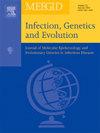An integrated approach for genetic risk profiling of typhoid, tuberculosis, and cholera in local population of tehsil Haripur
IF 2.6
4区 医学
Q3 INFECTIOUS DISEASES
引用次数: 0
Abstract
Despite notable progress in public health throughout the 21st century, infectious diseases like tuberculosis, typhoid, and cholera remain serious threats to global health, particularly in high-risk regions. Understanding the genetic factors that influence susceptibility and resistance to these diseases is essential for developing more effective strategies for their prevention and treatment. This study investigates the genetic variations associated with these infectious diseases with a focus on regions where these diseases are most prevalent. The aim of this study is to identify genetic variants that may influence susceptibility to tuberculosis, typhoid, and cholera. A thorough analysis of genetic variants associated with susceptibility and resistance to tuberculosis, typhoid, and cholera was conducted. Using publicly available genetic data from various ethnic groups. The allele frequency of the prioritized variants was calculated to assess their distribution within the different populations, including Middle Eastern, Ashkenazi Jewish, European (Non-Finnish), Latino/Admixed American, South Asian, East Asian, European (Finnish), North Asian, Southeast Asian, African American, and Swedish populations. The variants of the IL1β gene exhibiting the highest allele frequencies in the South Asian population were identified and subsequently examined within the local population. Specifically, the variants rs1143627 and rs1143629, which demonstrate the highest allele frequencies and are associated with typhoid, tuberculosis, and cholera, were subjected to detailed analysis. To determine their distribution and potential impact on disease susceptibility. In the local population, statistical analysis of the available sample revealed allele frequencies of 0.1128 % for IL1β (rs1143627) and 0.18 % for IL1β (rs1143629). Furthermore, these findings revealed that certain genetic profiles may play a role in the population's overall response to infectious diseases such as tuberculosis, typhoid, and cholera. This research has the potential to guide future public health strategies for more effective management and prevention of these diseases.
哈里普尔特希尔当地人群伤寒、肺结核和霍乱遗传风险综合分析方法
尽管整个21世纪在公共卫生方面取得了显著进展,但结核病、伤寒和霍乱等传染病仍然严重威胁着全球健康,特别是在高风险地区。了解影响这些疾病易感性和抗性的遗传因素对于制定更有效的预防和治疗策略至关重要。本研究调查了与这些传染病相关的遗传变异,重点关注这些疾病最流行的地区。本研究的目的是确定可能影响结核病、伤寒和霍乱易感性的遗传变异。对与结核病、伤寒和霍乱的易感性和耐药性相关的遗传变异进行了全面分析。利用来自不同种族群体的公开基因数据。计算优先变异的等位基因频率以评估其在不同人群中的分布,包括中东人、德系犹太人、欧洲人(非芬兰人)、拉丁裔/混血儿美国人、南亚人、东亚人、欧洲人(芬兰人)、北亚人、东南亚人、非裔美国人和瑞典人。在南亚人群中发现了il - 1β基因的变异,等位基因频率最高,随后在当地人群中进行了检测。具体来说,rs1143627和rs1143629变体显示出最高的等位基因频率,并与伤寒、肺结核和霍乱相关,对它们进行了详细的分析。确定其分布及其对疾病易感性的潜在影响。在当地人群中,对现有样本的统计分析显示,il - 1β (rs1143627)和il - 1β (rs1143629)的等位基因频率分别为0.1128%和0.18%。此外,这些研究结果表明,某些基因谱可能在人群对结核病、伤寒和霍乱等传染病的总体反应中发挥作用。这项研究有可能指导未来的公共卫生战略,以更有效地管理和预防这些疾病。
本文章由计算机程序翻译,如有差异,请以英文原文为准。
求助全文
约1分钟内获得全文
求助全文
来源期刊

Infection Genetics and Evolution
医学-传染病学
CiteScore
8.40
自引率
0.00%
发文量
215
审稿时长
82 days
期刊介绍:
(aka Journal of Molecular Epidemiology and Evolutionary Genetics of Infectious Diseases -- MEEGID)
Infectious diseases constitute one of the main challenges to medical science in the coming century. The impressive development of molecular megatechnologies and of bioinformatics have greatly increased our knowledge of the evolution, transmission and pathogenicity of infectious diseases. Research has shown that host susceptibility to many infectious diseases has a genetic basis. Furthermore, much is now known on the molecular epidemiology, evolution and virulence of pathogenic agents, as well as their resistance to drugs, vaccines, and antibiotics. Equally, research on the genetics of disease vectors has greatly improved our understanding of their systematics, has increased our capacity to identify target populations for control or intervention, and has provided detailed information on the mechanisms of insecticide resistance.
However, the genetics and evolutionary biology of hosts, pathogens and vectors have tended to develop as three separate fields of research. This artificial compartmentalisation is of concern due to our growing appreciation of the strong co-evolutionary interactions among hosts, pathogens and vectors.
Infection, Genetics and Evolution and its companion congress [MEEGID](http://www.meegidconference.com/) (for Molecular Epidemiology and Evolutionary Genetics of Infectious Diseases) are the main forum acting for the cross-fertilization between evolutionary science and biomedical research on infectious diseases.
Infection, Genetics and Evolution is the only journal that welcomes articles dealing with the genetics and evolutionary biology of hosts, pathogens and vectors, and coevolution processes among them in relation to infection and disease manifestation. All infectious models enter the scope of the journal, including pathogens of humans, animals and plants, either parasites, fungi, bacteria, viruses or prions. The journal welcomes articles dealing with genetics, population genetics, genomics, postgenomics, gene expression, evolutionary biology, population dynamics, mathematical modeling and bioinformatics. We also provide many author benefits, such as free PDFs, a liberal copyright policy, special discounts on Elsevier publications and much more. Please click here for more information on our author services .
 求助内容:
求助内容: 应助结果提醒方式:
应助结果提醒方式:


